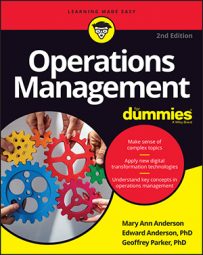Inventory management is one of the most difficult tasks in operations because it’s hard to predict actual customer demand. You can approach inventory management in many different ways. The right one for any given situation depends on the specific business environment.
Establishing a cost-efficient inventory management system — a process that determines how much inventory you need and when — requires knowledge of three specific variables:
Customer demand forecast: Because point forecasts (a single estimate for expected demand) are always inaccurate, your forecasts should always include information on expected average demand and a measure of the potential variability in demand.
Inventory costs: Reliable estimates of inventory costs should contain expenses related to ordering and holding inventory and costs of lost sales and goodwill if insufficient inventory is available to meet demand.
Lead time: Accurate estimates of expected delivery lead time for raw material and other manufacturing components (time between a placed order and delivery) and the variability of this time is critical to planning inventory levels. You also need to add in how long it will take you to process those materials into a finished product.
Many different inventory management systems are available, but they all share one goal: Get the right products to the right place at the right time. To figure out which system is the right one for you to achieve this goal in light of your business environment and infrastructure, you need to answer four basic inventory questions:
Can I reorder? In most cases, you can place orders to replenish stock that sells. But this isn’t always the case. In the fashion industry, for example, restocking isn’t usually an option. The best approach for managing inventory is fundamentally different for businesses that can and can’t restock inventory.
When can I review inventory levels? If you can reorder, choosing when to review inventory levels is crucial. Often, inventory review can occur either continuously or periodically. If monitored continuously, inventory can be ordered whenever a certain set point is reached. In many cases it’s impractical to constantly watch inventory, so you can set a designated time period to review levels and place orders; this is called periodic review.
How much do I need to order? Regardless of the review system you use, you need to consider expected demand, costs, and delivery times when deciding how much inventory to order at any one time.
When is the best time to place an order? If you can reorder product, then you need to figure out when to place the reorder. This decision tends to go hand in hand with how you choose to monitor inventory levels.
Modern inventory software makes monitoring inventory much easier than it was in the old days of counting boxes. Computer programs have all but eliminated the need to take a physical count of inventory in most cases.
Counting usually takes place only at tax time to value the inventory or to verify the accuracy of the software count. This means you can now maintain a near-constant tally of inventory and even link with supplier systems, thereby automating the ordering process.
The periodic review system, despite requiring slightly higher inventory levels, offers many advantages over continuous review systems. It simplifies operations because you can set a specific time for a resource to place all necessary orders. It allows you to consolidate shipments if you purchase multiple products from the same supplier, and it simplifies life for the supplier because the supplier knows when to expect an order from you.
Just because you place orders periodically doesn’t mean you don’t continuously track inventory through a point-of-sales system or bar coding. It only means that you’ve set a designated time to place an order rather than placing an order when the level reaches a set point.
Effective inventory management hinges on choosing the best process for reviewing inventory levels, which depends on your particular business. Basically, inventory review can be continuous, periodic, or isolated as a single period. Most of today’s inventory review programs are based on one or more of these basic systems.

